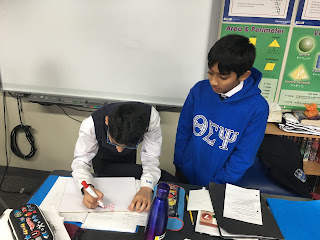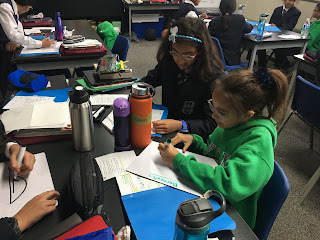I hope you have all had a fantastic week!
A few quick reminders:
· Monday is a Day 6 (we have gym so students will need devices).
· Aftercare invoices for the month of October have come out and are due Friday, October 15th, 2019. Any questions can be directed to Ms. Chiappetta at echiappetta@stjudesacademy.com
· Field Trip permission forms were sent home for our trip to the Canadian Warplane Heritage Museum on November 21st. The cost is $27 – please return forms and money as soon as possible.
· Curling permission forms and waiver forms were sent home today and are due back Thursday, November 7th. This trip has no cost as it was already paid for in the athletic fees during registration.
We started the day by presenting our knowledgeable awards at our assembly! Fantastic job everyone, and great job to the winners in our class – Ahil & Rajan.
Inquiry into Math – We started the day by taking up yesterday’s homework. Then, we dove right into surface area of rectangular prisms.
The surface area of an object is the total area of the surface of an object. This is a measurement of the area on the outside of a 3D object. When we are looking at surface area, we are using 3 different variables – length (how long is the object?), width (how wide is the object?), and height (how tall/high is the object?).
We then examined what happens when you unfold a 3D shape, which is that you get a net (2D version). When we examined surface area last year, we learned that you can calculate the individual areas of each rectangle and then add them all together. This year, we looked more closely at our prism net. We identified all the measurements on our net.
Yesterday, we learned about how we use variables in measurement formulas (a variable is a letter (or symbol) that represents a quantity that can vary). We identified what numbers we would multiply in each rectangle to get the area. We took another step and identified what variables we needed to multiply to get each area. What we observes was that ‘lw’, ‘lh’, and ‘wh’ all occur twice in the prism.
Therefore, to calculate surface area, we add everything together…
SA = lw + lw + lh + lh + wh + wh
Since we are repeating addition in our formula, we multiply.
SA = 2lw + 2lh + 2wh
We can even go one step further and say that we are multiplying these measurements once each, adding them together, and then doubling them.
SA = 2(lw + lh + wh)
Music – Then, we had music with Mr. Oliver, which you can read about on his blog (https://mrolivermusicclass.blogspot.com).
French – After this, we had French with Mme. Stella, which you can read about on her blog (https://stjudesfrench-stella.blogspot.com).
Inquiry into Math – After lunch, we continued with math. We did a few examples to calculate the surface area of rectangular prisms.
Then, we examined what happens when you double each of the dimensions.
Then, we examined what happens when you double each of the dimensions.
If we take an ordinary piece of paper, we can examine this. Imagine this rectangle represents the area of one of the sides of your rectangular prism. First, we have our paper.
Then, we double our first dimension.
Then, we double our second dimension.
Let’s represent the area of our original rectangle with the variable ‘A’.
When we double both dimensions, we get four congruent rectangles each with an area of ‘A’. That means that our new rectangle has four times the area of our original rectangle.
Since this will happen on each face of the prism, we end with a surface area that is four times as large as the original surface area we started with when we double the dimensions. So, we can say that if we double our dimensions, we multiply the surface area by 4.
Inquiry into Air – Yesterday, we learned about Bernoulli’s Principle. Let’s review:
A scientist named Daniel Bernoulli (Bernoulli’s Principle) discovered that where there is faster moving air, the pressure will be lower. This air foil is the shape of a plane’s wing. The ‘hump’ moves toward the air, and the air resists movement (moves toward the plane). The air that goes above the wing reaches the other side as the air that goes below the wing. Here is what we uncovered:
· Above the wing, there is greater surface area.
· Above the wing, there is faster moving air (it has to move faster to reach the other end at the same time).
· Below the wing, there is lower surface area.
· Below the wing, there is slower moving air (it moves slower to reach the other end at the same time).
If we apply Bernoulli’s Principle, above the wing (where surface area is greater and air is faster), there is low pressure. That means that below the wing (where surface area is less and air is slower), there is higher pressure. Since the pressure is below the wing is greater than that above the wing, the plane is propelled upward. This creates lift. If the force of lift is greater than gravity, the plane is able to fly.
After this, we did an activity (a carousel) where students sat and explained how planes fly using Bernoulli’s Principle to each other using words and diagrams.
They gave their peers feedback on their explanations. Each student explained the principle twice and gave feedback to their peers twice. Students were sent home with a worksheet to make notes on Bernoulli’s Principle and a checklist of what they should know. If they practice this, they will be able to complete the test with ease. To review:
They gave their peers feedback on their explanations. Each student explained the principle twice and gave feedback to their peers twice. Students were sent home with a worksheet to make notes on Bernoulli’s Principle and a checklist of what they should know. If they practice this, they will be able to complete the test with ease. To review:
· What is the shape of an airfoil?
· What direction is the plane travelling?
· What is the direction of the air?
· What is the distance air travels above and below the airfoil?
· What is the speed of the above and below the airfoil?
· What is the air pressure above and below the airfoil?
· What is the direction of lift?
Along with these questions, students should be able to use the correct vocabulary and draw a diagram that demonstrates this like mine below.
We will have a test on Monday with one question – Use Bernoulli’s Principle to describe how lift is produced in an airfoil.
Inquiry into Language – After this, we worked on our book reports for City of Ember.
Science Fair – At the end of the day, we worked on our cars. Science Fair is quickly approaching. Students are encouraged to come earlier to school to work on their cars (I will be here for 7:30 each day). Students are also encouraged to use their recess times to complete their cars.
Homework:
We do our best to complete work in class. In the event this is not possible, it will go home for homework.
As always, please feel free to email me with any questions.
Mr. Conte




























































